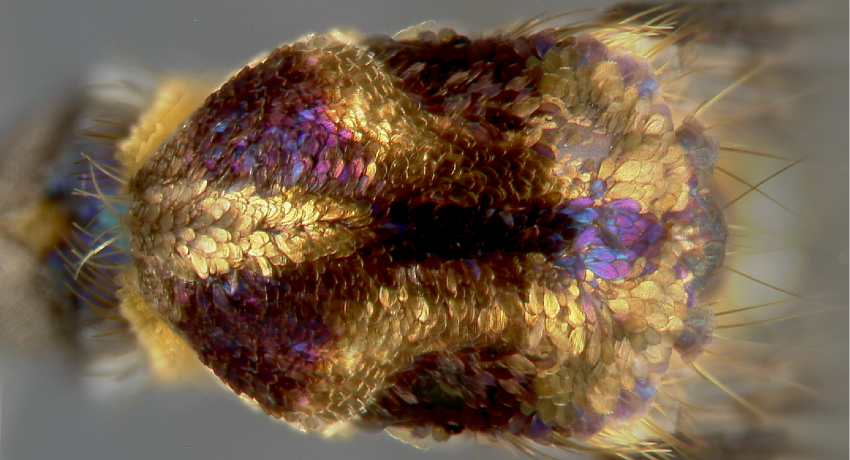NEOTROPICAL REGION
Generic abbreviation: Li.
Type species: Limatus durhamii Theobald,1907 (in subfam. Limatinae).
Etymology: not stated (filed, polished (L))
The Neotropical forest-dependent genus Limatus comprises eight species: Li. andinus Leví-Castillo, Li. asulleptus (Theobald), Li. durhamii Theobald, Li. flavisetosus de Oliveira Castro, Li. guayasi Leví-Castillo, Li. hoffmani Root, Li. martiali Senevet & Abonnenc, and Li. pseudomethysticus (Bonne-Wepster & Bonne). Limatus species are found from Mexico to Argentina in Central and South America, and on Trinidad and Tobago in the West Indies.
DIAGNOSTIC CHARACTERS (Click photos to view; mouse over and click large photo to zoom in.)
ADULT (illustrated): Thorax: Scutum covered with gold, blue, and violet scales; prespiracular scales present, but no setae. Legs: Unguis (U-III) single [unique amongst Sabethines].
LARVA (not illustrated): Head: Maxilla without an apical tooth; occipital foramen with short and broad caudolateral slits; setae 1-C closely approximated.
TAXONOMIC KEYS
None
![]()
WRBU – Genera – Global – Larva
![]()
WRBU – Genera – Neotropical – Adult
![]()
WRBU – Genera – Neotropical – Larva
Exemplar DNA sequences
Li. durhamii COI: MF172330–34
Li. flavisetosus COI: KF671027; MF172335–37
BIONOMICS
Immatures
Limatus immatures occupy canopy and ground habitats where water collects including: cavities in broken bamboo canes, tree holes, coconut husks, cacao pods, fallen palm spathes, snail shells, rock holes along streams, and in many small artificial containers. Limatus larvae (1–27 per shell) were found in empty Megalobulimus snail shells in Argentina. In Rio de Janeiro, Brazil, Limatus durhamii shares larval habitats in urban forests with the invasive Aedes albopictus, but the species are inversely correlated in the Brazilian Atlantic Forest.
Adults
Adult Limatus occupy all levels of the canopy, and are considered nuisance pests in forest regions. Limatus species readily feed on people and female Li. durhamii are common in human biting collections. In Costa Rica, Limatus asulleptus and Li. durhamii are found from sea level to 1800m elevation. Limatus durhamii, Li. flavisetosus and Li. pseudomethisticus have been implicated in arboviral transmission.
*Associated pathogens: This list reports bacteria, viruses, and parasites recovered from, or experimentally passed through this species, and does not imply field vector status.
IMPORTANT REFERENCES (full citations below)
Theobald 1901c: 349 (as genus)
Lane 1953 (revision, keys, taxonomy, bionomics, distribution)
Forattini 1965 (review, taxonomy, bionomics, distribution)
Cova-García et al. 1966 (taxonomy, distribution; Venezuela)
Belkin et al. 1970 (taxonomy; Jamaica)
Harbach & Peyton 1993 (L mouthparts; taxonomy, phylogeny)
Motta et al. 2007 (phylogeny)
Harbach & Kitching 1998 (phylogeny)
Harbach & Peyton 2000 (phylogeny)
Harbach et al. 2007b (phylogeny)
VALID SUBGENERA
None
CURRENT GENERIC SYNONYMS
syn. Simondella Laveran 1902c: 1160 (as genus). Type species: Simondella curvirostris Laveran.
syn. Lemmamyia Dyar 1919d: 140 (as genus). Type species: Limatus methysticus Dyar & Knab.
CITED REFERENCES
Belkin, J.N., Heinemann, S.J., & Page, W.A. (1970). The Culicidae of Jamaica (Mosquito studies. XXI). Contributions of the American Entomological Institute, 6(1), 458.
Cova García, P., Oramas, E.S., & Rausseo, J.A. (1966). Mosquitos (Culicinos) de Venezuela. II. Ministerio de Sanidad y Asistencia Social, Caracas, 413pp.
Cova García, P., Sutil Oramas, E., & Rausseo, J.A. (1966). Mosquitos (Culicinos) de Venezuela. I. Ministerio de Sanidad y Asistencia Social, Caracas, 410pp.
Dyar, H.G. (1919d). A revision of the American Sabethini of the Sabethes group by the male genitalia (Diptera, Culicidae). Insecutor Inscitiae Menstruus, 7, 114–142.
Forattini, O.P. (1965). Entomología Médica. 3.0 Volume. Culicini: Haemagogus, Mansonia, Culiseta, Sabethini, Toxorhynchitini. Arboviruses. Filariose bancroftiana. São Paulo: Universidade de São Paulo.
Harbach, R.E. & Kitching, I.J. (1998). Phylogeny and classification of the Culicidae (Diptera). Systematic Entomology, 23(4), 327–370.
Harbach, R.E., & Peyton, E.L. (1993). Morphology and evolution of the larval maxilla and its importance in the classification of the Sabethini (Diptera: Culicidae). Mosquito Systematics, 25(1), 1–16.
Harbach, R.E., & Peyton, E.L. (2000). Systematics of Onirion, a new genus of Sabethini (Diptera: Culicidae) from the Neotropical region. Bulletin of the Natural History Museum London (Entomology), 69, 115–159.
Harbach, R.E., Huong, V.E., & Kitching, I.J. (2007b). Systematics of Kimia, a new genus of Sabethini (Diptera: Culicidae) in the Oriental Region. Proceedings of the Entomological Society of Washington, 109(1), 102–120.
Lane, J. (1953). Neotropical Culicidae (Vols. I, II). São Paulo: University of São Paulo.
Laveran, A. (1902c). [Note]. In P. L. Simond (Ed.), Description d'un moustique dont le male possede un trompe faucille (Vol. 54, pp. 1158–1160). Paris: Comptes Rendus Hebdomadaires Des Seances De L'academie Des Sciences Serie D Sciences Naturelles.
Motta, M.A., Lourenço-de-Oliveira, R., & Sallum, M.A.M. (2007). Phylogeny of genus Wyeomyia (Diptera: Culicidae) inferred from morphological and allozyme data. Canadian Entomologist, 139(5), 591–627.
Theobald, F.V. (1901c). A monograph of the Culicidae or mosquitoes (Vol. 2). London: British Museum (Natural History). with Atlas of 37 colored pls. + 5 pls. of photographs.
CITE THIS PAGE
Walter Reed Biosystematics Unit (Year). Limatus genus page. Walter Reed Biosystematics Unit Website, http://wrbu.si.edu/vectorspecies/genera/limatus, accessed on [date (e.g. 03 February 2020) when you last viewed the site].






